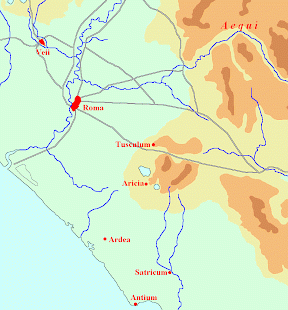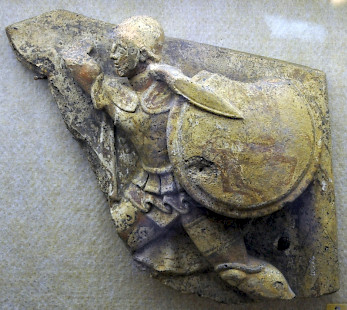Volsci
Q663655Volsci: ancient people, originally living in the western Apennines. Migrating to southern Latium, they became one of the four main enemies of archaic Rome.

In the course of the Iron Age, the people of Central Italy, who had been living in hilltop settlements, increasingly started to live in larger groups, often consisting of several older settlements. In the coastal area, with access to the sea and easy roads on the plains, this process culminated in the growth of real cities, like Antium, Satricum, archaic Rome, Praeneste, Veii, and Caere. In the hilly interior, this process was a bit slower, but larger political units were created as well, which are often, for lack of anything better, labeled as "tribal". From north to south, we can discern four people: the Sabines in the valley of the river Tiber, the Aequi, the Hernici in the valley of the Tolerus (or Trerus) River (modern Sacco), and the Volsci, who originally lived in the valley of the Liris.
The powerful kings of Rome (e.g, Tarquin the Proud) were able to keep those tribes away. Livy mentions a war between Tarquin the Proud and the Volsci. However, after the collapse of the Roman monarchy in the final decade of the sixth century, the Aequi and Volsci started to migrate to the plains. The Aequi seized political control of eastern Latium, including towns like Praeneste, while the Volsci are often mentioned in southern Latium, on the Pontine Plain.

Responding to this crisis, the Latin towns formed the Foedus Cassianum, a confederation of mutual military alliance, led by the Romans. It may have been a return to the earlier situation, in which Rome was the main city in Latium. To defend the region, several colonies were founded: Signia in the east, the port of Circeii in the extreme southeast, Cora halfway between Rome and Circeii, and Pometia on the central plain.
It was in vain. The Volsci were succesful. Among the towns they added to their himeland in the Liris valley, were Velitrae, the port of Antium, Satricum (formerly Pometia), Privernum, Circeii, Tarracina (another port), Fundi. Probably, Volscian chieftains seized control in towns that had once been governed by Latin leaders. Material culture did not change substantially; the second phase of the Temple of Mater Matuta in Satricum offers an idea of Volscian art and architecture.

In the course of the fifth century, there were several conflicts between this Latin League and the Volsci, who often cooperated with the Aequi. The Hernici, living between the two allies, allied themselves to the Romans and Latins. One of the Volscian generals was, according to the tradition, a Roman renegade named Coriolanus.
The fights lasted for all of the fifth century. The war for Tarracina, also called Anxur, forced the Romans to start paying their soldiers. In the end, Rome restored control over Latiun in the first half of the fourth century. In the second half of this century, they would go on to attack the mountain people beyond the Volsci: the Samnites. In the 330s, when the Latin towns revolted agains Rome, the Volsci supported the rebels, but after their final defeat, they vanish from history.
The Volsci spoke an Osco-Umbrian language.